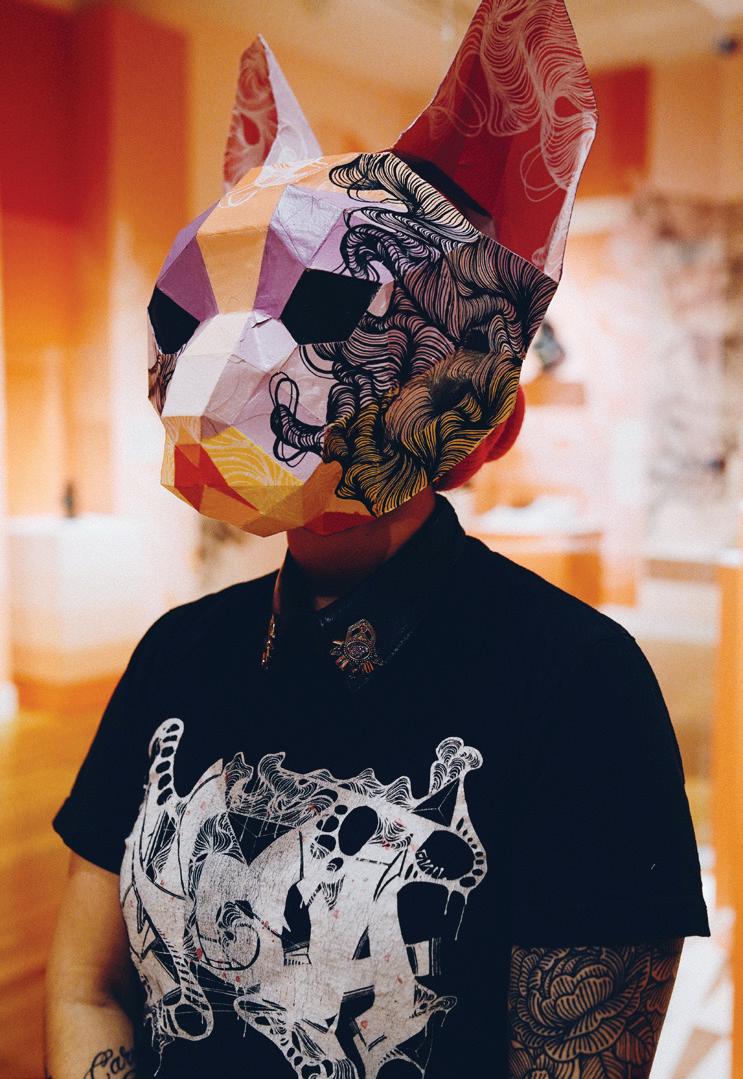
16 minute read
THE SUFFRAGIST BY RHIANNON FIONN
THE SUFFRAGIST
Pg. 11 APR 22 - MAY 5, 2020 - QCNERVE.COM A TALE OF TWO PANDEMICS How the 1918 u pandemic played into women’s su rage BY RHIANNON FIONN
In the nineteen teens, when duty called soldiers to war and a u pandemic was killing entire families, women worldwide stepped up and took on many roles traditionally held by men. However, by the time both of those nightmares began, young American women in the National Women’s Party (NWP) — including North Carolina’s Gertrude Weil — had yanked the helm of the su rage movement away from their elders who had spent decades trying to bargain with Congress. Then they turned up the heat.
Yet they still were not taken seriously a century after the call for women’s su rage began. It took World War I and nearly 700,000 u-related deaths in the U.S. alone before President Woodrow Wilson o ered support for the 19th Amendment.
P r e v i o u s l y , I wrote in “The Su ragist” that the push to amend the U.S. Constitution began in the mid-1840s. I was corrected by a Civics 101 podcast from New Hampshire Public Radio featuring Professor Martha Jones of John Hopkins University. According to her forthcoming book, Vanguard: How Black Women Broke Barriers, Won the Vote and Fought for Rights for All, AfricanAmerican women like Maria Stewart were speaking to audiences and writing manifestos about su rage as early as the 1820s.
So, by the time WWI began, not only had a century passed since then, but the women from the NWP had for more than two years stood in front of the White House as “Silent Sentinels” enduring periodic torture.
Still, all Wilson managed to say in support of the 19th Amendment was, “…we have made partners of the women in this war … Shall we admit them only to a partnership of su ering and sacri ce and toil and not to a partnership of privilege and right?”
Unlike our current president, with his neardaily, ultra-long and self-focused press brie ngs, Wilson didn’t have much to say about the u pandemic. Of course, he was focused on WWI, which the United States entered on April 6, 1917. A year later, the rst incidence of what would later (inaccurately) be referred to as the Spanish u showed up at a military camp in Kansas, according to the U.S. Centers for Disease Control (CDC).
The reason that virus wasn’t called the Kansas Flu is because our president, and leaders of other countries involved in World War I, didn’t want to take people’s attention away from the war e ort so they tried to keep the lid on u news. It’s called the Spanish Flu because the media in Spain, which wasn’t then tangled in war, could tell the truth.
Even here in Charlotte, public o cials and medical professionals misled the public about the devastation, as Mark Washburn explained recently in his article in The Charlotte Observer showing how even the city’s newspapers downplayed that pandemic. PSA CIRCA NOV. 1918

Meanwhile, the virus began to do what viruses do: replicate and invade every available host lacking immunity, leading to a death toll that would exceed 50 million worldwide, depending on your source.
“Soldiers in crowded training camps were especially vulnerable. At the railroad station that served Camp Greene near Charlotte co ns were stacked from oor to ceiling, taking home the bodies of young soldiers who never saw the war,” wrote Harry McKown in a University of North Carolina article entitled “North Carolina and the ‘Blue Death’.”
According to UNC Charlotte associate professor Dr. Heather Perry, “There was the same uproar about closed businesses and loss of income at that time. People resisted the quarantine and there was a lot of pushback against the public health measures which were implemented to help stop the spread — usually because people did not like being told what to do or because they chose personal economic concerns over public health ones. So, of course, that is one reason why the u was so bad in Charlotte.”
In the meantime, women got to work, as they are wont to do. That same proactive determination to help during crisis, to do whatever must be done, is evidenced today in the faces of the pregnant nurses worrying in news reports. We see it on the hunched backs of those working feverishly behind sewing machines and 3D printers making cloth masks, gowns, face shields and other accoutrements for medical professionals, other frontline workers and high-risk individuals. We see it in the men and women running cash registers in checkout lines and delivering our food.
Now there’s a new su rage battle in front of us: mail-in voting, something the leadership of the N.C. General Assembly, which returns to session April 28, has already said they’re not interested in (read Mary’s column to my left for more on that).
For the coming battles we all need to focus and work hard, while also pacing ourselves and practicing self-care and physical distancing so that we, too, don’t succumb to COVID-19, our new viral enemy.
“When people died during the 1918-1920 in uenza pandemics — yes, there were multiple waves (and we can expect multiple waves of COVID-19) — due to a variety of reasons, a cause of death was not listed,” wrote Perry in an email explaining why accurate numbers for deaths in Charlotte during the u pandemic aren’t available.
“Keep in mind that the u pandemic didn’t end in November 1918. In fact, although the city lifted the quarantine at the end of October 1918, they had to put the city schools and other areas back under quarantine in December because there had been such a resurgence of cases. In Char-Meck, people were still getting sick regularly and dying until well into 1919,” says Perry.
That is why mail-in voting is of utmost importance during a presidential election, because both scientists and historians like Perry are saying the same thing: Viruses don’t adhere to our timelines; we bend to theirs. They can change everything, and they don’t care about our hard-earned rights — so we must be smarter than them. INFO@QCNERVE.COM WOMEN WORKERS’ WW1 POSTER.


Pg. 12 APR 22 - MAY 5, 2020 - QCNERVE.COM Classic Black was meant to be a radical departure for the museum, the confluence of classic sculpture and a contemporary street artist whose reputation is based on her colorful and immersive murals. Equally if not more important, Owl is a woman of color. A show prominently featuring such an artist is still far from common in the art world, or the museum world, and it lends resonance to the exhibit’s title.
“It was definitely unconventional for the museum to move forward with this,” Crowell offers.
The seeds for the groundbreaking installation were planted by Mint’s curator of decorative arts Brian Gallagher shortly after he joined the museum’s staff in 2007. Rummaging through the museum’s storeroom, he noticed distinctive sculptures of black basalt, a dense stoneware made from reddish-brown clay which burns black in firing. After conducting research, Gallagher concluded that the pieces were produced by 18th-century English master potter and entrepreneur Josiah Wedgwood, as well as some of his contemporaries. These rare pieces, many of them ceramic copies of ancient Greek, Roman, Renaissance and Enlightenment sculptures, had never been shown at the Mint before. Gallagher convinced his colleagues that the ceramics could form the core of an exhibition.
Then, museum life happened, Gallagher says. Other projects and exhibits took precedence, but the notion of a Wedgwood exhibit continued to gain adherents.
Four years ago, Gallagher resumed the project, arranging to borrow other vintage black basalt pieces from England’s Wedgwood Museum, the Victoria & Albert Museum and the National Trust, as well as Alabama’s Birmingham Museum of Art in America. As the exhibit entered the design phase, Crowell came onboard.
In his factories, Wedgwood had industrialized the potter’s craft, Gallagher explains, thereby making his wares available and affordable for the rising middle class. Crowell describes Wedgwood’s studios as the IKEA showrooms of their day.
“He was the first to open a showroom in London, the first to have traveling salesmen, [and] the first to offer money-back guarantees and free shipping — things we take for granted today,” Gallagher explains.
Realizing that consummate marketer Wedgwood was pitching his wares to homeowners, Gallagher decided that he wanted to avoid a stark presentation of black ceramics against white walls. He and Crowell decided to incorporate the warm hues prevalent in late 18th-century homes, colors which would also resonate with contemporary tastes.
Crowell arranged the collection into three separate rooms that would reflect the domestic focus of Wedgwood’s black basalts. Drawing on her background in theatre design, Crowell often describes the sculptures as characters in a play.
“I took the classical characters of antiquity [and] Greek and Roman mythology and created a ‘sculpture hall’ for them to live in,” she says. Busts of writers, philosophers and politicians of the Enlightenment landed in the “library.” A “drawing room” was then set up for decorative “objects that were what the fashionistas of the 18th century would buy,” Crowell offers.
The architecture was in place, but the exhibit’s walls still needed to be decorated and painted. In Wedgwood’s day, popular architect and designer Robert Adam was the consummate tastemaker with a neoclassical style that incorporated frescos by Italian painters to move a patron’s eye around the space, Crowell says. Many of Wedgwood’s pieces were designed to mesh with Adam’s style.
“The Adam style uses moldings and painted motifs and color in a very specific way,” she explains. “One of the things that was important to the style was a lot of visual movement.” Crowell knew where to find that kind of movement in contemporary art — Charlotte’s exploding street arts scene. When the Mint co-hosted the street mural slam competition Battle Walls with Southern Tiger Collective last summer, she noticed the work of collective artists Owl and her partner Arko. ARTS FEATURE A LOOK INSIDE OWL’S ‘CLASSIC BLACK’ EXHIBIT, FEATURING BASALT SCULPTURES BY JOSIAH WEDGWOOD. OWL AS CAT? PHOTO BY CASEY HENDRICKSON PHOTO BY DANIEL ALVARADO PUBLIC ISOLATION Street artist Owl shifts from prestigious museum to home studio BY PAT MORAN
Owl is used to uncertainty. In March, the Colombian-born Charlotte artist learned that Classic Black, a conjoined sculpture and mural exhibit she cocreated with members of the Mint Museum staff, would be closing prematurely to help stem the rapidly rising tide of COVID-19. The Mint hopes to reopen the show, which was originally scheduled to run Feb. 9 to Aug. 30, at their Randolph location, but dates have yet to be determined. In the meantime, Owl took the shifting situation in stride. The acclaimed muralist, who often appears masked when she’s creating in public, had hoped that her first museum show would increase her art’s accessibility, but that caveat aside, she felt satisfied that all her hard work had paid off.
“What we planned to do was brought [forth] with the best intentions,” Owl maintains. “It also showed me that I was part of a community because [after the closure] the Mint Museum reached out — a lot of people reached out — to make sure that I was okay.”
She’s grateful that she was able to create the installation before the city ground to a halt, and has found solace that people were reaching out to each other amid the pandemic. “I felt there was uncertainty but that we all were going to be walking hand in hand.”
Classic Black: The Basalt Sculpture of Wedgwood and his Contemporaries represented a series of firsts for the artist and for the Mint. It was the first exhibit to focus exclusively on the black basalt sculpture made by Josiah Wedgwood and other Staffordshire potters in late 18th-century England, as well as the Mint’s first sculpture exhibit.
For Mint exhibition designer Hannah Crowell,
Pg. 13 APR 22 - MAY 5, 2020 - QCNERVE.COM
“I want my community to go out to the museum to see that we are out there,” Owl told Queen City Nerve in early March, before the museum closed. “Accessibility is a big part of my goal in the arts.”
Seeing her bio in the museum was a powerful moment for her, Owl explains. “As a child of immigrants, it was the best gift I could give my parents.”
Then, in mid-March, the Mint announced that they were closing until further notice. One of Owl’s closest friends came up from Atlanta to visit on the Mint’s final day, Saturday, March 15. With her friend, Owl toured the museum — and Classic Black — one last time.
“I had the opportunity to go back into that place where everything was born and created,” Owl remembers. “There wasn’t much sadness because I was still able to share it with someone who is close to me.” As life slowed down, Owl pivoted to creating under quarantine. It wasn’t that much of a transition, the artist maintains. “There were a few adjustments, but overall, the life that I have created and the environment that
I have set for my day was already set up for social distancing.” She’s not in complete isolation, because she shares her home with her partner Arko, who still works a day job as a surveyor.
Owl says she’s grateful to spend more time in her home studio digging deeper into projects that she had placed on the back burner. In early April she partnered with Camp North End-based design firm McFly Fresh Printing Company to release a new t-shirt.
“[McFly] is allowing me to create the designs … and [they] have it run for however long I need to bring in some income in these uncertain times,” Owl offers.
It’s a boon with commissioned projects drying up, she continues. Owl sees the shirts as a way to promote positivity with a message that ties in with what she was promoting at the Mint. The design incorporates a circle which she describes as an iconic Owl stamp. ARTS FEATURE
“[Owl’s] work is all about the movement of the eye and changing and morphing a line to create a movement of energy,” Crowell maintains. She wanted to bring that energy into the Mint, and she found an ally in Gallagher. They brought Owl in and told her of their plan to entwine sculpture, color and design in a conversation between the ancient art that inspired Wedgwood, the 18th-century design by embodied by Adam, and Owl’s contemporary and immersive mural work.
“I was in shock for a few minutes,” Owl remembers. “I was in front of two people who visualized something innovative. I had been wanting to do something like this for a very long time.”
Owl came back with a color scheme for the exhibit’s three rooms: warm pinks, oranges, purples and blues, hues and tones that evoked successive sunrises and sunsets viewed by generations of humans throughout the centuries. The design also incorporates Owl’s blobs, line drawings of amoebalike shapes that spiral in successive iterations like fractals. The blobs are like a two-dimensional Rorschach test that the eye reads as 3-D.
“There’s vertical movement [in Owl’s art] that surrounds and swirls around an object, so your eye has a moment to rest before it dances to the next focal point,” Crowell offers. “I [created] a slide that overlays some of her work on top of Robert Adam’s classical design. All the same ideas are there, where symmetry exists but [also] breaks.”
The show opened at the Mint’s Randolph Road location on Feb. 9. For Owl, an unexpected bonus of the show was that her bio was posted in the gallery. Because she often works masked and incognito, many people who love her art were not aware of what she looks like.
“People have messaged me when they read my bio at the Mint [and] they realized that I’m a woman of color,” Owl offers. Many of those people have told her she was an inspiration for girls and women, she continues.
MINUTES. I WAS IN FRONT OF TWO PEOPLE
WHO VISUALIZED
SOMETHING INNOVATIVE.” -Owl
“I feel this connection to the circle of life, and cycles of the moon’s orbit — all these cycles where something begins and ends and comes back to the same place. “
The positivity and energy come from the color of the shirt. “I picked yellow because it’s a color that brings hope and signifies peace.”
She’s also committed to producing a drawing every day for the next 30 days to provide templates for her next series of screen prints.
The drawings are pieces of a puzzle, an examination of how her brain processes experiences in a time of isolation and reflection, Owl offers. They are also an extension of her daily journals of thoughts and dreams.
“I wake up and the first thing I do is write down how I’m feeling and varying dreams that I can recall.” She started toying with the idea of drawing more constantly, adhering to a routine, and documenting how her brain is dealing with the new normal. “I’m finding more information than I thought I would actually find,” Owl maintains.
“I’ve done five drawings so far. In the first two you can tell there’s a lot on my mind.” By the third, fourth and fifth drawings, Owl realized that she had started pairing ideas together in ways she never had before.
She’s excited to see what the ensuing days will bring, and says that her drawing time is an exciting part of her day because she constantly surprises herself.
Owl is hopeful that Classic Black will reopen but she’s had no word on when that might be. In an email, Crowell writes that the Mint is pursuing an extension for the exhibition.
“Because many of the objects are on loan from private collections and public museum collections, we are working now on all the logistics,” Crowell offers.
In the meantime, Owl notes that everyone seems to be sharing the uncertainty of an artist’s life. “It’s where everybody is sitting at right now, being at home, figuring things out, seeing what works and doesn’t work and taking a chance on yourself. I think all of us needed to have our minds shaken so we could realize that we’re all in this together.”
“We’re going to come out of this stronger,” Owl maintains, noting that she’s seeing more and more simple acts of kindness between friends and neighbors daily. “We’ll be united, and a little bit kinder and appreciative.”
PMORAN@QCNERVE.COM













Out of this world dentistry finally in your neighborhood! -Locally owned 7am-7pm and select Saturdays -Offering Whole Family Dentistry & Oral Surgery specialty care on an extended schedule
No Insurance? No Problem! www.StellarDentalCLT.com Ask about our in-house Dental Savings Plan
University 9010 Glenwater Drive 704-547-1199






